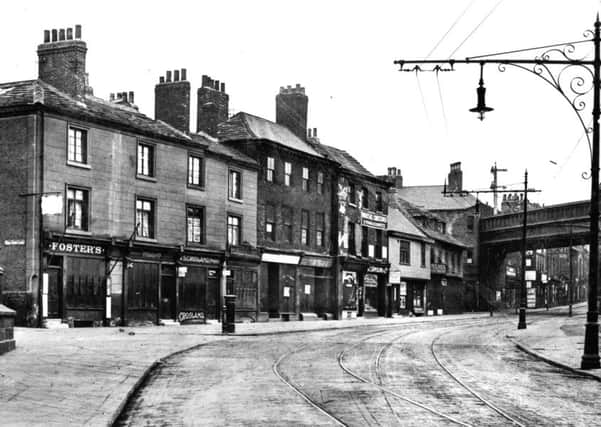Nostalgia on Tuesday: Story of a street


In the old Norse language, which was spoken by Viking settlers, Kirkgate is translated as ‘road to the church’. The area has had a place of worship since Anglo-Saxon times. As numbers grew, churches were established in important places such as Leeds, which was on two cross-country routes – over the Pennines to Manchester and north to York.
Early evidence of worship in Leeds was found by chance during the demolition of the bell tower of St Peter’s Church in 1838. Carved stone sections of large crosses were discovered and dated from around the 10th century when the Vikings ruled the area.
Advertisement
Hide AdAdvertisement
Hide AdThe Domesday Book commissioned by William the Conqueror notes that Leeds had a church with a priest, a manor and meadowland. A reconstruction drawing by Peter Brears in A History of Kirkgate (2016) imagines Kirkgate in 1089. The church is surrounded by a moat, and close by, to the west, is a hall and tithe barn. Extending from Kirkgate are strips of land and a number of cottages. Call Lane and The Calls are shown as dirt tracks with fields on either sides.
By the beginning of the 14th century, much income in Leeds manor was derived from agriculture and the wool trade, with Kirkgate residents involved. The wealth being generated encouraged the monks of Holy Trinity Priory to embark on the building of a mammoth stone church which was completed in 1377.
Holy Trinity Priory was surrendered on December 11, 1536, to Henry VIII’s commissioners and Kirkgate land and properties subsequently came on the market.
From the middle of the 16th century, Leeds was dominating the West Riding textile trade. Kirkgate clothiers prospered, living in timber-framed properties fronting the street, carrying out a number of the cloth processes themselves.
Advertisement
Hide AdAdvertisement
Hide AdIn the following century Leeds saw a sharp rise in the number of cloth merchants who eventually gained much power in the town. They successfully petitioned Charles I to grant a Royal Charter and create Leeds Corporation. This gave the merchants a number of commercial advantages which they embraced. A noted merchant who lived on Kirkgate in the prestigious Manor House was William Lowther. Earlier the property had been occupied by Edward Fairfax and Dr Henry Watkinson.
The Hearth Tax Returns of the late 17th century reveal there were 114 households in Kirkgate. Arguably, the street’s most noted resident was Ralph Thoresby (1658-1725). His father John, a rich cloth merchant, redeveloped a timber-framed property dating from 1508 in Kirkgate into larger premises. Ralph Thoresby was a merchant, as well as an antiquarian, fellow of the Royal Society, diarist and museum keeper.
Thoresby promoted the building of the First White Cloth Hall which opened in Kirkgate in 1711, catering for the producers of white or undyed cloth. The site was provided by Lord Irvine of Temple Newsam.
Cossins’s map of Leeds (1725) shows the First White Cloth Hall set back from Kirkgate and suggests that the principal facade was towards the south perhaps connecting it with the Call’s warehouses and dye-houses. The interior featured a series of store rooms for the clothiers of surrounding towns and hamlets. Names such as Bradford, Heckmondwike, Batley and Heaton could be seen on doors. Commenting on the building, Thoresby said: “[It] is a stately hall, built on pillars on arches in the form of an exchanges with a quadrangle court within.”
Advertisement
Hide AdAdvertisement
Hide AdWith trade rapidly expanding the facilities of this building were outgrown so a new white cloth hall, financed by the clothiers, was built just south of the river in Meadow Lane during 1756.
Once abandoned, the First White Cloth Hall was converted for other commercial purposes and altered accordingly. Among other merchant families living in Kirkgate were the Pawsons and the Cooksons.
Major occurrences during the 19th century in Kirkgate were the rebuilding of St Peter’s Church, the construction of a market hall and a railway which cut through overhead. By the 19th century, the church was large, but dirty, cluttered and unsafe. The arrival of a new vicar, Dr WF Hook, in 1838, saw the building of a new church – now Leeds Minster – with more than 1600 seats. It was consecrated on September 2, 1841.
Towards the mid-1800s, moves were made to build a market hall. In 1857 the hall, made from iron and glass, was completed.
Advertisement
Hide AdAdvertisement
Hide AdA railway stretching along a bridge over Kirkgate was established in the late 1860s and carried the North Eastern Railway company’s line to Leeds New Station.
A competition was staged in 1899 for designs for a new covered market. Leeming Brothers, of London, won the contest with a market hall projected to cost £73,000. Work began in 1901 and was finished in 1904.
Public houses that gained prominence in Kirkgate included the Golden Cock Inn, the Masons Arms, the Old Royal Oak, the Regent and the Duck and Drake. Several are still thriving today.
In the last few years an initiative for the revival of Kirkgate has been started. One of the aims is to bring historic buildings back to appropriate an sustainable uses. The First White Cloth Hall, now the earliest structure, is to be carefully restored following decades of commercial alterations and neglect.
Readers may also see A History of Kirkgate from Earliest Times to 1800, Steven Burt and Kevin Grady, illustrations by Peter Brears